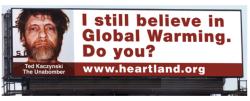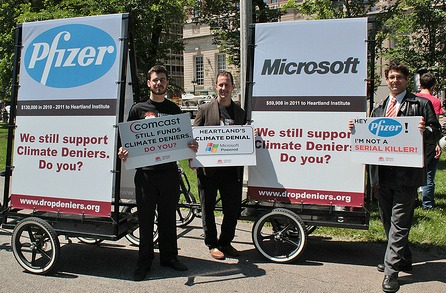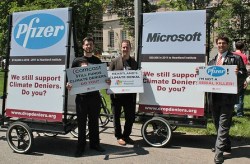It’s been a rough few weeks for the Heartland Institute, the “intellectual” nexus of the fossil fuel-powered machine that disparages climate science in the United States. Nineteen corporations have pulled more than $1 million in expected funding for the institute, leading President Joe Bast to ask attendees at the recent Heartland climate-denial conference whether they had a “rich uncle” who could help out. Seriously.
At a time when most news about climate change is bad, Heartland’s decline has been a rare bright spot. How did it come about? In the reductive rendering of the mainstream media, the narrative has become that Heartland simply overplayed its hand by launching a billboard campaign comparing people who believe in global warming to the Unabomber, one of the single dumbest PR moves in recent history. Others have gone deeper, pointing out that Heartland has been painting itself into the crazy corner for a long time, and its lies were bound to catch up with it eventually. In that view, Heartland’s demise was essentially inevitable.

The infamous Unabomber billboard.
While these narratives have elements of truth — the billboards were incredibly stupid, and Heartland has been lying for a long time — neither offers a full explanation because both deemphasize the crucial role of citizen action. Simply put, the post-billboard exodus of Heartland’s corporate donors would have been neither as big nor as fast if not for the actions of thousands of everyday Americans calling those donors to account. Indeed, it might not have happened at all.
For those who haven’t been closely following the saga, here is the basic chronology. In February, documents containing a list of Heartland funders were leaked to a number of bloggers by climate scientist Peter Gleick, who risked his professional reputation to expose the sources of Heartland’s support. Two days later, the organization I work for, Forecast the Facts, launched a campaign calling on all corporate funders of Heartland to withdraw their support, with our initial focus on General Motors. Within a week, more than 20,000 people, including 10,000 GM owners, had signed on. After adding their names to the effort, those citizen-activists then called GM, posted hundreds of comments on GM’s Facebook page, uploaded photos of themselves with their GM cars, showed up at events where GM’s CEO was speaking, and generally made it clear that they were extremely upset about GM’s Heartland association. After weeks of pressure, including considerable media coverage, GM pulled its support on March 28 — more than a month before the now infamous billboard went up.
Forecast the Facts isn’t an established player; our ability to influence General Motors was not due to our reputation. It was entirely the result of our active members, who organized around an idea and spoke in a louder voice than any single person or institution could.
Because GM’s pullout happened before Heartland’s Unabomber messaging fiasco — a key point that’s been overlooked by many media outlets — it offers the clearest demonstration of how citizen activism can impact corporations. There is literally nothing more valuable to a public-facing company like General Motors than its brand. And in the wake of the government bailout, GM has a great deal invested in building its environmental identity. Exhibit A: The Chevy Volt. Twenty thousand customers and potential customers pissed off about GM’s ties to climate-change denial represented a real threat to GM’s image makeover. Which is why GM’s CEO agreed to review the matter personally, and eventually decided that the company’s 20-year relationship with Heartland was just not worth the potential brand damage.
In the weeks following GM’s announcement, Forecast the Facts staff, together with partners at Greenpeace, contacted the rest of Heartland’s corporate donors to ask why they were still supporting climate-change denial. In doing so, we made clear that we were speaking on behalf of the 20,000 people who had signed on to the campaign. And our questions sparked conversations within many of those companies about whether the lobbying that Heartland did for them was worth the risk to their brands.
Then came the billboards. The companies that had already been thinking about leaving because of the aforementioned public pressure immediately did so. Another 150,000 people joined our campaign through groups including 350.org, SumOfUs.org, the League of Conservation Voters, and the Sierra Club. And again, these people did more than just sign a petition. Thousands posted on company Facebook pages and chipped in to fund billboards calling out remaining Heartland holdouts, hundreds made phone calls to corporate headquarters, and dozens showed up in person to protest Heartland’s conference. All of those actions sent a message to Heartland’s remaining donors: There are a lot of people who care about this issue, and your brand is at risk. In response, corporate supporters have continued to scurry for the exits.
I’ve asked a number of people why citizen activism tends to get short shrift, and I’ve gotten a lot of thoughtful responses. One of them stuck out as the most likely explanation: People like the idea that Heartland carried within it the seeds of its own destruction — that is, Heartland consists of a bunch of unhinged conspiracy theorists who mislead the public for a living, and they were destined to eventually destroy themselves because scientific truth inevitably wins. While that teleology is attractive, it ignores the fact that the truth only wins when enough people stand up on its behalf.
Institutions like Heartland don’t fail just because they lie to the public. If that were true, Heartland would have disintegrated a long time ago, the U.S. Chamber of Commerce would be defunct, and the corporate-funded campaign to discredit science would no longer hinder our societal response to the climate threat. Institutions like Heartland only crumble when people speak up and say they are tired of being lied to, and provide a credible threat to whomever makes the misinformation possible — in this case, hypocritical corporate donors that profess to care about climate change while simultaneously supporting a group dedicated to the exact opposite purpose.
A shift in cultural attitudes and attendant policy changes will only come when enough people consistently, loudly, and unrepentantly reject climate denial and demand action. So when everyday people do exactly that, and their actions make an impact, they deserve to be credited. We need to reinforce the behavior that is our only hope for real progress on climate change.




